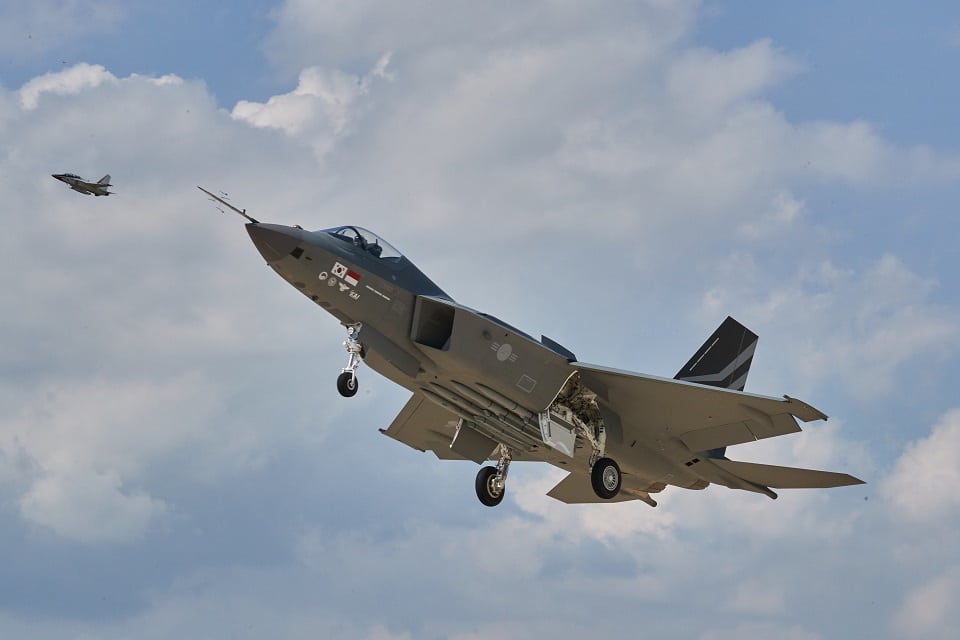Aerospace
UAE reportedly seeking a role in KF21 fighter jet

The Financial News, a South Korean daily, said on Thursday that the UAE’s Tawazun Economic Council had sent a letter to South Korea’s Office of National Security explaining Abu Dhabi’s desire in direct cooperation on the development of the KF-21.
Surprisingly, the letter allegedly requested that Abu Dhabi replace Indonesia’s investment in the program.
South Korea’s KF-21 Boramae Takes To the Air(Opens in a new browser tab)
Indonesia holds a 20% shareholding but has failed to meet its financial obligations. Jakarta, which had planned to purchase up to 50 KF-21s, joined the program in 2010 but fell behind on payments in 2017, owing an estimated $557 million by July 2022. In May, Jakarta attempted to assuage Seoul’s fears by announcing a revised payment schedule.
The KF-21 Boramae’s stealth capabilities are a crucial feature. The aircraft is equipped with modern stealth technology such as a low-observable design, radar-absorbent materials, and internal weapon carriage.
These features lower the radar cross-section of the aircraft, making it more difficult to detect and track hostile radars. The KF-21’s stealth characteristics increase its survivability and allow it to more effectively infiltrate opposing defenses.
The UAE’s alleged interest is not surprising. After all, Abu Dhabi pledged $30 billion in South Korean businesses, including defense, in January. The affluent Arab kingdom inked a $3.5 billion contract with South Korea for the Cheongung II KM-SAM air defense missile system in January 2022, the largest-ever arms export transaction for Seoul at the time.
As these multibillion-dollar investments in the South Korean industry illustrate, the UAE would have little issue repaying Indonesia’s debt to the Boramae programme. Furthermore, Abu Dhabi would surely be interested in co-producing the fighter since it would aid in the development of its domestic defence sector through significant technology transfers, which Seoul has proven to be generous with.
The UAE has halted talks with the US over a record sale for 50 fifth-generation F-35 Lightning II stealth planes in late 2021 due to differences over American preconditions and Emirati cooperation with China.
The KF-21 Boramae is powered by two General Electric F414-GE-400K afterburning turbofan engines. These engines provide the necessary thrust for the aircraft’s high-performance capabilities. The F414 engines are known for their reliability, fuel efficiency, and ability to operate in various environmental conditions. They enable the KF-21 to achieve the supersonic speeds and maneuverability required for air combat scenarios.
On the other hand, India, China, and Turkey are already in the process of developing their own Fifth Generation Fighter Jet. Turkey has already exhibited it and is awaiting the final engine selection for their 5th generation fighter plane. Americans are looking forward to the 6th generation fighter jet, which will be the most advanced in terms of engine thrust and weapons technology.
Most countries are working together to develop collaborative efforts to build their own fighter plane.

Aerospace
Boeing Transfers Rocket Stage to NASA, Paving Way for Human Moon Mission

Boeing has achieved a significant milestone by providing NASA with the second core stage of the Space Launch System (SLS) rocket.
This crucial component, crafted at NASA’s Michoud Assembly Facility (MAF), is set to propel the Artemis II crew into lunar orbit, marking humanity’s return to deep space after a 50-year hiatus.
The monumental Boeing-built rocket stage, the largest element of the Artemis II mission, will embark on a journey aboard the Pegasus barge, traveling 900 miles to NASA’s Kennedy Space Center.
Comparison of two legendary aircraft B777x vs B747 aircraft:Click here
Upon arrival, it will be meticulously integrated with other essential Artemis II components, including the upper stage, solid rocket boosters, and NASA’s Orion spacecraft within the iconic Vehicle Assembly Building. This intricate integration process is a vital step toward the eagerly anticipated Artemis II launch, slated for 2025.
“Boeing-built products helped land humankind on the moon in 1969, and we’re proud to continue that legacy through the Artemis generation,” remarked Dave Dutcher, vice president and program manager for Boeing’s SLS program. “Together, with NASA and our industry partners and suppliers, we are building the world’s most capable rocket and paving the way to deep space through America’s rocket factory in New Orleans.”
NASA, Lockheed Martin Reveal X-59 Quiet Supersonic Aircraft:Click here
The delivery of Core Stage 2 marks a significant achievement in the evolution of the SLS rocket. Towering over 200 feet and powered by four RS-25 engines, this core stage, coupled with two solid-fueled booster rockets, will generate a staggering 8.8 million pounds of thrust. This immense power is crucial to launching Artemis II and future missions into the vast expanse of space.
The SLS rocket stands unparalleled in its capability to transport both crew and substantial cargo to the moon and beyond in a single launch. Its extraordinary capacity will facilitate the delivery of human-rated spacecraft, habitats, and scientific missions to destinations including the moon and Mars, ushering in a new era of space exploration.
-

 Travel1 week ago
Travel1 week agoAir India to Expand US Operations with Three New Routes After a Decade
-

 Travel2 weeks ago
Travel2 weeks agoWhy We Should Avoid These Stamps in a Passport
-

 Airlines1 month ago
Airlines1 month agoInvestigations Reveal Fake Chinese Titanium in Boeing and Airbus Jets
-

 Tech4 weeks ago
Tech4 weeks agoChina’s CATL Plans 1,800-Mile Electric Plane Launch by 2027
-

 Airport3 days ago
Airport3 days agoTop 10 Largest Airports in the World by Size
-

 Aerospace4 weeks ago
Aerospace4 weeks agoChina’s Fighter Jets Turn Wings into Autonomous Drones
-

 Airlines4 days ago
Airlines4 days agoAir India Rolls Out A350s for Delhi-New York JFK and Newark Routes
-

 Defence3 weeks ago
Defence3 weeks agoBoeing Enhances Chinook with New Engines and Block II Upgrades at $96 Million







